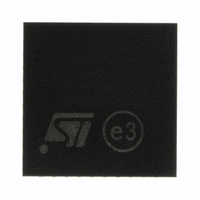SN260Q STMicroelectronics, SN260Q Datasheet - Page 17

SN260Q
Manufacturer Part Number
SN260Q
Description
IC ZIGBEE/802.15.4 PROC 40-QFN
Manufacturer
STMicroelectronics
Datasheet
1.SN260Q.pdf
(47 pages)
Specifications of SN260Q
Frequency
2.4GHz
Modulation Or Protocol
802.15.4
Applications
ZigBee™
Power - Output
-32dBm ~ 5dBm
Sensitivity
-97.5dBm
Voltage - Supply
2.1 V ~ 3.6 V
Current - Receiving
35.5mA
Current - Transmitting
35.5mA
Data Interface
PCB, Surface Mount
Antenna Connector
PCB, Surface Mount
Operating Temperature
-40°C ~ 85°C
Package / Case
40-QFN
For Use With
497-6404 - BOARD EVAL SPZB260 MOD FOR STR9497-5990 - KIT EVAL REVA FOR ZIGBEE497-5879 - NETWORK DEVELOPMENT FOR SN260497-5877 - KIT RADIO CARRIER FOR SN260
Lead Free Status / RoHS Status
Lead free / RoHS Compliant
Memory Size
-
Data Rate - Maximum
-
SN260
6.5
6.6
6.6.1
16-bit microprocessor
The SN260 integrates the XAP2b microprocessor developed by Cambridge Consultants
Ltd., making it a true network processor solution. The XAP2b is a 16-bit Harvard
architecture processor with separate program and data address spaces. The word width is
16 bits for both the program and data sides.
The standard XAP2 microprocessor and accompanying software tools have been enhanced
to create the XAP2b microprocessor used in the SN260. The XAP2b adds data-side byte
addressing support to the XAP2 allowing for more productive usage of RAM and optimized
code.
The XAP2b clock speed is 12MHz. When used with the EmberZNet stack, firmware may be
loaded into Flash memory using the SIF mechanism (described in
programming and debug
bootloader1 in a reserved area of the Flash. Alternatively, firmware may be loaded via the
SIF interface with the assistance of RAM-based utility routines also loaded via SIF.
Embedded memory
The SN260 contains embedded Flash and RAM memory for firmware storage and
execution. In addition it partitions a portion of the Flash for simulated EEPROM and token
storage.
Simulated EEPROM
The protocol stack reserves a section of Flash memory to provide simulated EEPROM
storage area for stack and customer tokens. The Flash cell has been qualified for a data
retention time of >100 years at room temperature and is rated to have a guaranteed 1,000
write/erase cycles. Because the Flash cells are qualified for up to 1,000 write cycles, the
simulated EEPROM implements an effective wear-leveling algorithm which effectively
extends the number of write cycles for individual tokens.
The number of set-token operations is finite due to the write cycle limitation of the Flash. It is
not possible to guarantee an exact number of set-token operations because the life of the
simulated EEPROM depends on which tokens are written and how often.
The SN260 stores non-volatile information necessary for network operation as well as 8
tokens available to the Host. The majority of internal tokens are only written when the
SN260 performs a network join or leave operation. As a simple estimate of possible set-
token operations, consider an SN260 in a stable network (no joins or leaves) not sending
any messages where the Host uses only one of the 8-byte tokens available to it. Under this
scenario, a very rough estimate results in approximately 330,000 possible set-token
operations. The number of possible set-token calls, though, depends on which tokens are
being set, so the ratios of set-token calls for each token plays a large factor. A very rough
estimate for the total number of times an App token can be set is approximately 320,000.
These estimates would typically increase if the SN260 is kept closer to room temperature,
since the 1,000 guaranteed write cycles of the Flash is for across temperature.
interface) or over the air or by a serial link using a built-in
Section 9: SIF module
Functional description
17/47












